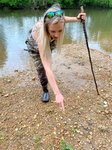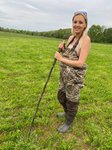




For half a decade, Ocean Atwell has spent her free time trekking the fields of Webster County, uncovering forgotten artifacts. Her grandparents moved to Webster County in the 70s from their homestead in California and her family has been here ever since.
“My name’s only Ocean because my parents are hippies,” she laughed. “Growing up in California, my school was actually half Native American… we were on the reservations in California and the girls would make fun of me because I’m a white girl with that name so that was kind of funny. Now, the amount of respect I have for it probably stems from growing up with that experience.”
Atwell typically finds arrowheads on her excursions, however she has come across other artifacts such as bear teeth, bone tools, kitchen tools and nutting rocks, which were large stones with a space carved to place a nut, in order to break it open. Each find is special and carries a unique story with a special place in history.
“The best part of when you find it is that these artifacts are hundreds of years old. So you picture what the person who made it looked like, what the area looked like and it’s crazy to think that there were hundreds and thousands of people on these properties… the history is unreal,” she explained. “It’s so old, you’d have to find old, old diaries of families that were here hundreds of years ago and maybe they would have information on it. Thats it. There’s not a lot of information on native people in Webster County.”
Atwell explained that her research into which areas to hunt are often topographical, depending on where she believes indigenous peoples would have made camp in relativity to water, high ground and areas that would have sustained vegetation. When you find larger concentrations of flakes you know you’re close to where they would have been.
“Natives would have had to counter floods but also be close enough that they didn’t have to hike all day to get water to camp,” she added. “You have to kind of read the land and see the valleys, hills and look for material… that’s where they would have camped.”
She hunts alongside her significant other, James Townlain and with their unborn baby, J.R. The soon-to-be parents scour creeks, rivers and plowed fields. Though she’s 34 weeks pregnant, she doesn’t let it slow down her lifestyle.
“We haven’t stopped… between all the things that we do normally, we’re pretty active people,” she said. “I haven’t stopped arrowhead hunting but we did buy J.R. a handmade arrowhead case and all the ones I’ve found while I’m pregnant we’re putting in there for his nursery.”
The historian also keeps detailed journals of her special finds, with a log of information.
“I keep track of every point and log where I find them. I’ll also keep a site ID which I use clear nail polish and a sharpie and mark on the arrowhead so it can be removed, but it organizes the artifacts and keeps a log of the information that I do have about them,” she said. “Then I have a map key so that a museum or native researchers or anyone who may be interested in those types of thing can know where the sites were, what was found and it helps with trade pieces because you will find materials from other states here.”
For reference, Atwell uses textbooks about local Missouri Native Americans and Indigenous people of all North America. There are hundreds of thousands of different types of points that can be identified on arrowheads. By finding out what type of point an artifact has, one can determine its age, location of origin and the span of where it was found. She said she keeps her journals both for her own memories, as well as for the fact that they may be useful to any researchers who may come to our area in the future.
One thing to keep in mind for those getting started in artifact hunting is that there are several “unwritten rules” of the sport. For example, hunters should only tread on property that they own or that they’ve received permission to hunt on. It’s also important to leave things exactly where they are if a hunter is unsure of what they’ve found.
“Native people could be buried with a large area of artifacts, which has never happened to me, but it does happen,” she explained. “Those type of things are important to keep in mind… you’re not allowed to dig up anything ceremonial because it’s unethical.”
While these artifacts have been covered for hundreds of years, every spring and fall during planting seasons they will pop up in fields. Many can also be found in rivers after it floods. While they are everywhere in the Ozarks, Atwell said there seems to be an age gap in hobbyists from what she’s seen.
“I’ll go to trade shows and notice that there is a big gap between ages but it’s important because it’s history. A lot of people do it as a hobby but some of these artifacts are worth money, some are worth a lot of money,” she added. “But whatever gets people interested…”
As for her, she said it’s her favorite past time. She does it for exercise, to be out in the sun and connect with nature, and for the thrill she gets when she find something. She hasn’t sold anything from her collection, she just lets it grow. According to Atwell, arrowhead hunting is an all-around exhilarating experience that everyone should try at least once.
“They don’t teach about this in school but it’s important because they’ve already been laying in the ground for hundreds or thousands of years. There’s only so many traces of history left and the Trail of Tears went right through Marshfield. So arrowheads have been found everywhere… you just have to look down.”
Comments
No comments on this item Please log in to comment by clicking here